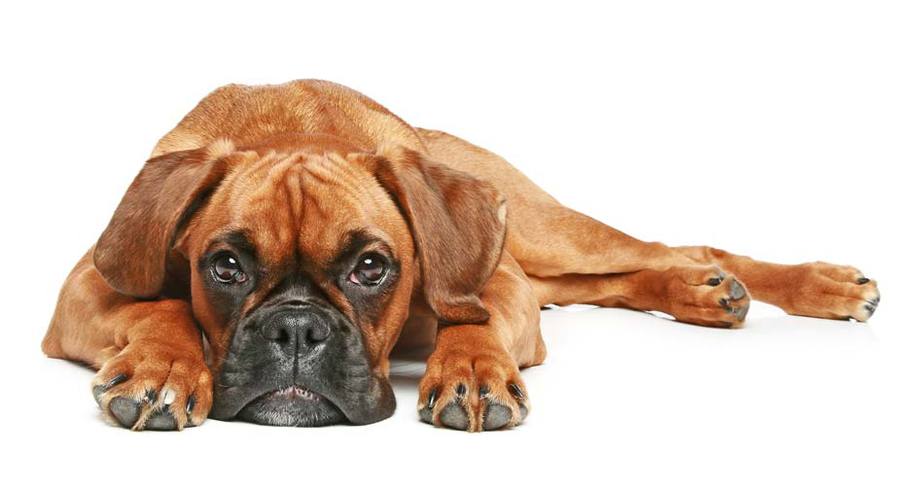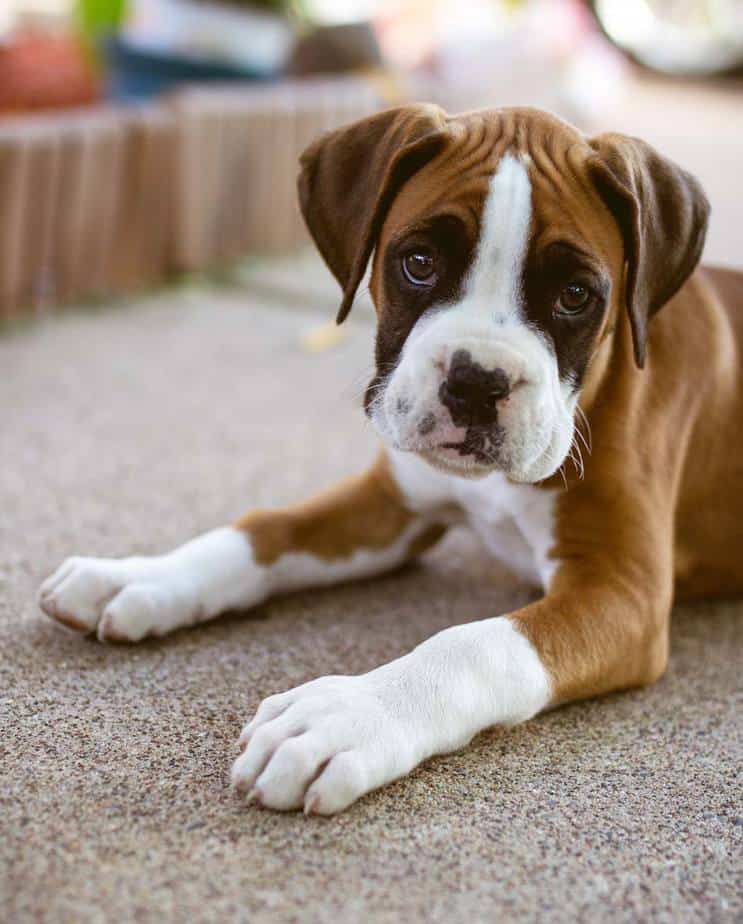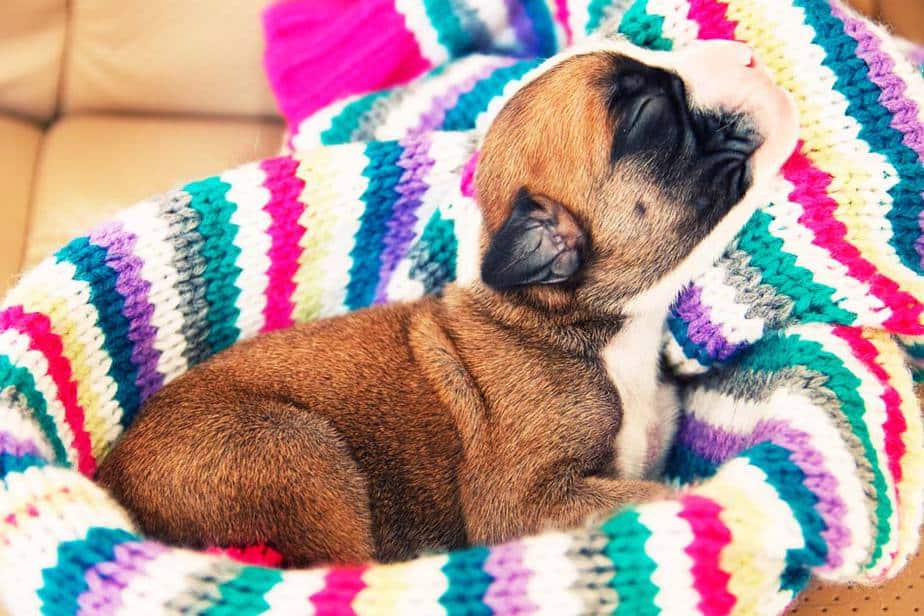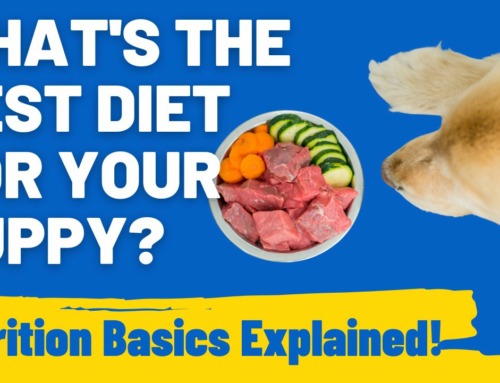While all puppies go through an awkward growth phase, it sometimes seems like Boxer puppies get hit particularly hard! One day they’re round and roly-poly, and the next it seems like you’ve starved your growing Boxer puppy. In this post we’ll examine how a Boxer should look when they’re at a healthy weight, how to tell if your Boxer puppy is too skinny, reasons why they may be skinny, and expectations for their growth.
How Can I Tell if My Boxer Puppy is Too Skinny?
There are several charts and guidelines to follow to tell if your Boxer puppy is too skinny. Sometimes, they are skinny because of health concerns or underfeeding. However, the structure of a Boxer is different from some other breeds, which can make it tricky to determine if they are skinnier than they should be.
In general, Boxers should not be a heavy-set breed. Adding extra and unnecessary weight to your Boxer puppy, especially when they’re growing, can be extremely harmful to their health. Especially since Boxers can be prone to heart conditions, including “Boxer cardiomyopathy,” it’s important to make sure your Boxer isn’t overweight, either!
However, a lean dog breed such as the Boxer should still have well-defined muscles and substance. Ideally, you shouldn’t be able to see your Boxer puppy’s spine or hip bones protruding.
Your Boxer puppy’s ribs should be covered with a thin layer of fat, but not so much that you can’t feel them.
Appearances can be deceiving when looking at ribs. Sometimes a dog that appears skinny is just inhaling and has short fur, such as your Boxer puppy does.

If you aren’t sure what your Boxer puppy’s ribs should feel like, make a fist with one hand. With your other hand, feel across the back of your fingers, just above your knuckles. This is what healthy ribs feel like – you can feel the indents but also the padding.
On the contrast, your knuckles are what your dog’s ribs will feel like if they are too skinny, with lots of depth between each rib. Finally, the back of your hand is what your Boxer’s ribs will feel like if they’re overweight – you can barely feel the bones, it’s mostly just a padding of fat.
While the ideal adult Boxer will not have protruding spine or hip bones, and ribs that are not excessively showy, your Boxer puppy is prone to odd stages of growth that may make them even skinnier than normal.
This is normal for the Boxer breed, and breed enthusiasts often call it the “Boxer Dog Skinny Phase.” This can happen throughout their adolescence and early adulthood. Once your Boxer is 2-3 years old, they will have reached a more mature phase of growth and should no longer be excessively skinny.
If you think your Boxer puppy is too skinny, the first step in many cases is to try and increase their food or switch to a food with more calories. Puppies need more energy to grow than adult dogs, so what an adult Boxer eats is usually less than a Boxer puppy.
Sometimes, though, it’s not as simple as increasing their food.

Reasons Your Boxer Puppy May Be Too Skinny
Other than a lack of nutrition, there are several other reasons why your Boxer puppy may appear skinny. Most of these reasons are health-related – and as always, if you suspect that your puppy is ill, a visit to their veterinarian is in order.
One option is that your puppy may have internal parasites, or worms. Puppies in general are extremely prone to picking up parasites, especially if they didn’t receive regular deworming as a puppy.
These parasites live in your dog’s intestinal tract, taking away nutrition from your puppy for themselves. In some cases, worms can give puppies a pot bellied appearance, since they lack the leftover nutrition to keep themselves healthy but instead have a large stomach full of worms.
Sometimes you will see the parasites in your puppy’s fecal matter – they often appear as white pieces of spaghetti or grains of white rice. However, many times the worms can live inside your puppy without ever appearing to your naked eye.
If you suspect that your puppy may have worms, the best way to confirm is to take a fecal sample to the veterinarian. They will be able to conduct a fecal test, which will find even small eggs or particles of the worms that you can’t normally see.
Another reason for your Boxer puppy to appear too skinny is when they are exercising more than usual. It’s important to be careful of exercising puppies too much when they’re growing, since exercise can damage their growth plates. However, if your Boxer puppy is spending more time than usual running around the yard or playing with friends, they might need more food to compensate.
Finally, your Boxer puppy might look so skinny just because they’re a Boxer! As we previously mentioned, this breed is prone to awkward growth phases that require extra calories – and they often look too skinny during these phases even if they are well-fed.

Average Boxer Puppy Weight Chart
Your Boxer’s weight will vary based upon their individual proportions and adult size, but we’ve put together a chart of the average weights for you to use. In general, your Boxer puppy shouldn’t vary too much from this chart – or if they do, it can indicate that they are underweight or overweight.
| Age (Months) | Weight (lbs) |
|---|---|
| 2 | 10 |
| 3 | 23 |
| 4 | 32 |
| 5 | 40 |
| 6 | 45 |
| 8 | 50 |
| 10 | 53 |
| 18 | 55-75 (depending on sex) |
As you can see from the chart, puppies will gain weight rapidly in the first 6 months, and then their growth will start to slow until they reach maturity.
How to “Fatten Up” a Boxer
If you’ve determined that your Boxer puppy is indeed too skinny, there are several things you can try to help them gain weight and reach a healthier size.
First, you should evaluate the food you are feeding your Boxer puppy. Sometimes, your puppy will just need more of their food than normal. Other times, they may not actually be getting enough calories in their meals.
If your Boxer puppy is eating a food that is lower in calories, they may be getting full before they consume enough. You can try switching your puppy to a food with higher calories to see if you can add some weight to your puppy.
Sometimes, during the skinny phase of a Boxer’s growth, they actually need something other than their kibble to sustain their weight. Tuna, eggs, peanut butter, and cottage cheese are just a few ideas for snacks that can be added to your Boxer puppy’s diet to provide them with additional calories.
Final Thoughts
There are many reasons why your Boxer puppy appears skinny – and many of them aren’t a huge cause for alarm. It’s relatively normal for the breed to need some extra calories or look a tad skinny as they grow.
However, if additional food isn’t helping, or if you suspect a medical problem, the best solution is to take your Boxer puppy to your veterinarian. Feeding additional calories alone won’t help if there is something else going on medically.




